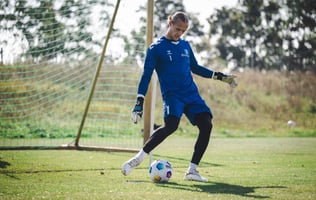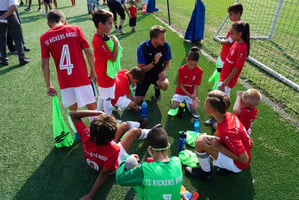Utilise modern training methods to take every football goalkeeper to the next level. Basics of...
Essential footballdrills to improve player performance
In today's digital world, technology has found its way into the training of team sports, revolutionizing popular games such as football.
For this reason, the main concern is to make training fun, interactive and structured so that players can identify with the game and improve their skills at the same time. In a practical way, you can teach a player exercises in football, both beginners and advanced players who want to improve their skills. In doing so, an app provides personalized training, tracks progress and enables different drills tailored to each level. By incorporating these drills into training programs and rapidly increasing their complexity, coaches and trainers can help players develop the physical and technical attributes necessary for success on the pitch.

Types of football drills
1. Kettlebell swings
Kettlebell swings are usually underrated but have proven to be very effective in their application. This exercise is recommended for its ability to develop lower body strength, particularly in the hip extensors. This is an important exercise to protect the hamstrings and enhance their ability to generate explosiveness in movements such as sprinting and changing direction.
In this exercise, a squat is performed before the jump, which leads to a high load during execution. The drop squat with concentric jump is an underestimated exercise that can generate a relevant impulse despite the low load. The exercise increases a person's ability for spontaneity and strength and at the same time tests the neuromuscular system.
3. Drop Jumps
The aim of this exercise is to shorten the contact time and improve the mobility of the ankle joint. This has many benefits for football players. Athletes can track their contact times using tracking devices and receive feedback to record their progress or adjust their performance accordingly.
4. Multidirectional lunges
Postural control needs to be challenged in different ways, e.g. using an external object such as a sloshing bag to motivate players to optimize their ability to maintain balance during deceleration. This training puts less strain on the legs. It is well suited for intensive training because the load is kept to a minimum.
5. Lateral jumps
Lateral jumps over a certain distance, combined with feedback on contact times, are a very valuable exercise for players. This exercise focuses on the lateral strength, stability and coordination required to dodge and change direction on the football field. The type of activities are commonly performed by players, but the intensity required to achieve a physical change is often overlooked.
In summary, it is very important that football training includes different types of exercises and game forms if the player wants to improve his skills and overall performance on the pitch. There are specific exercises and workouts for certain skills such as speed, agility, strength or ball control that greatly influence them. Doing these exercises regularly will not only help your child grow, but will also lead to your team's success. With the apps for teaching football drills, you can quickly learn the most important steps to prepare for the game. The app provides a step-by-step guide to train players through drills and game forms on the pitch. The goal is to make football a sport that all players will love for a lifetime.



